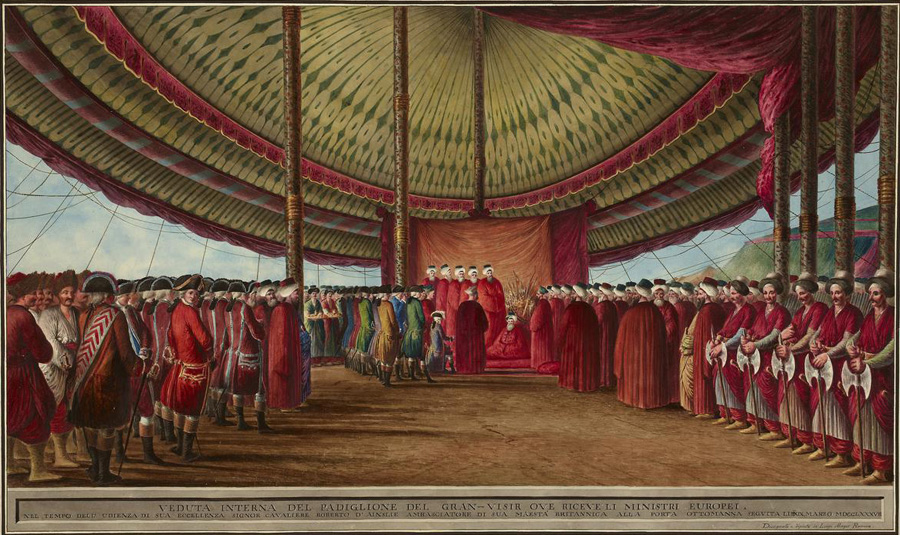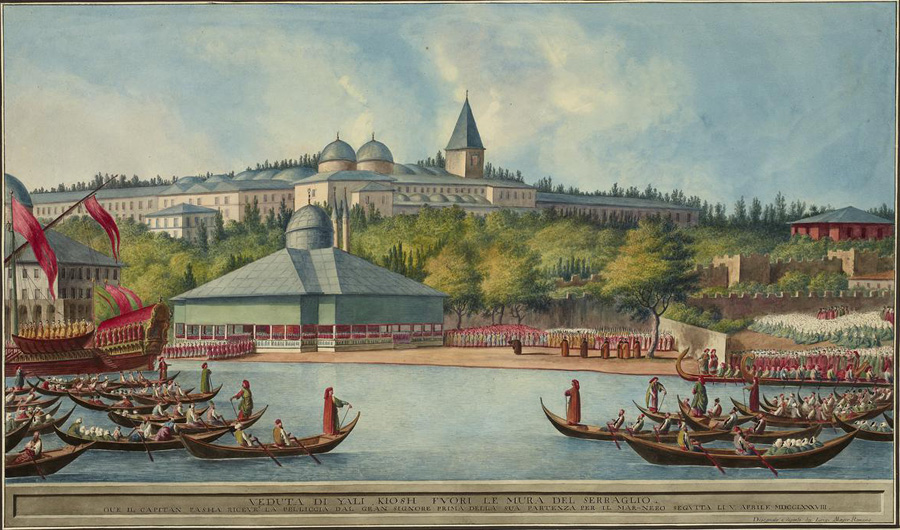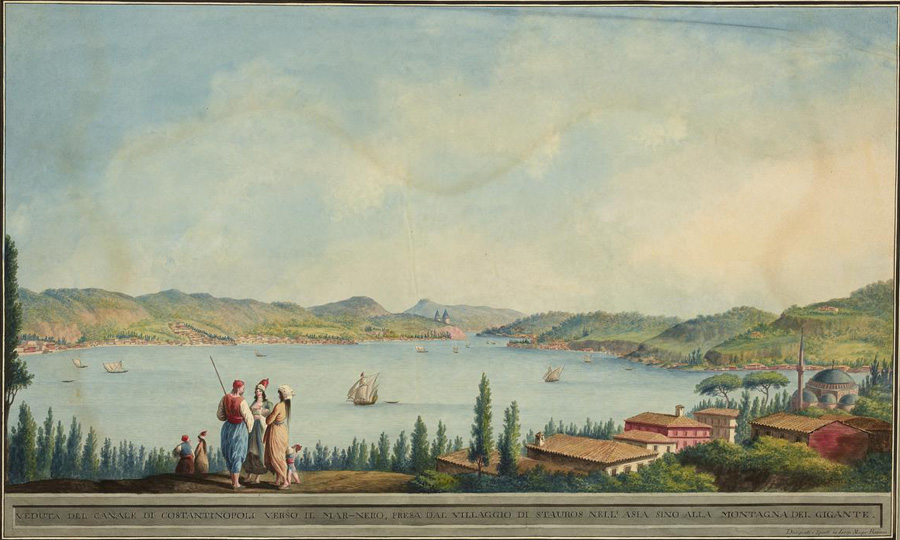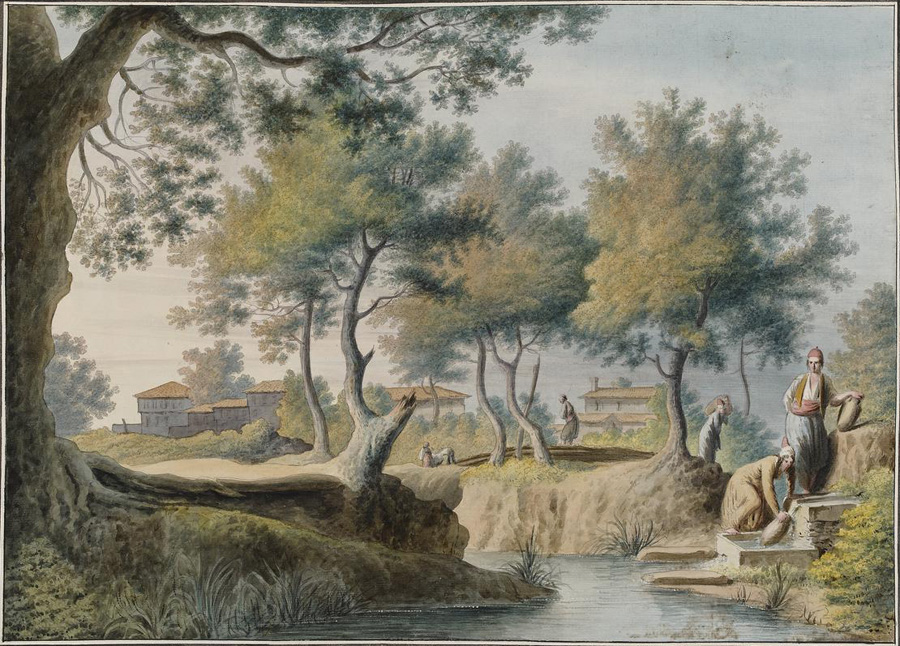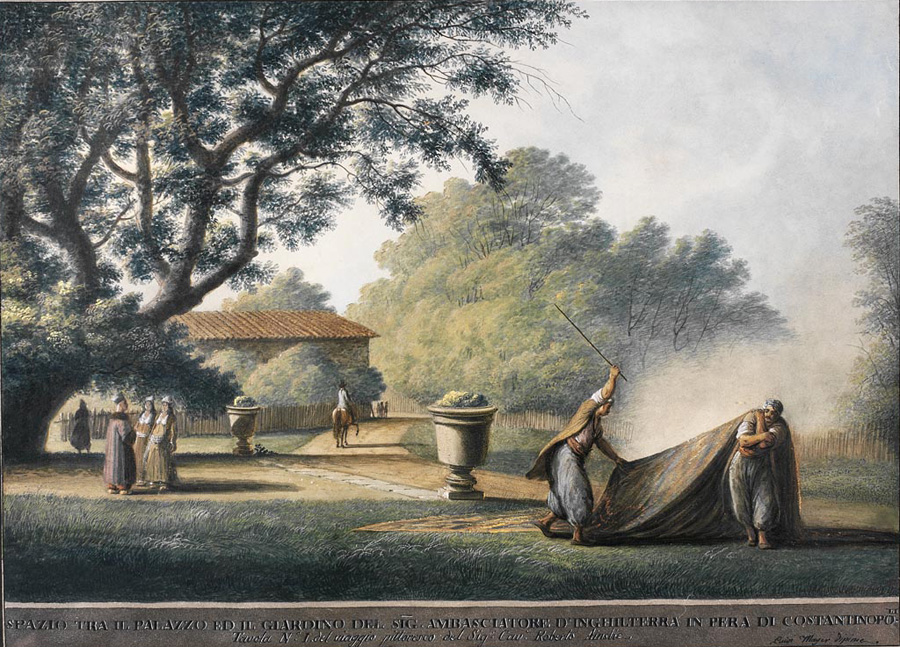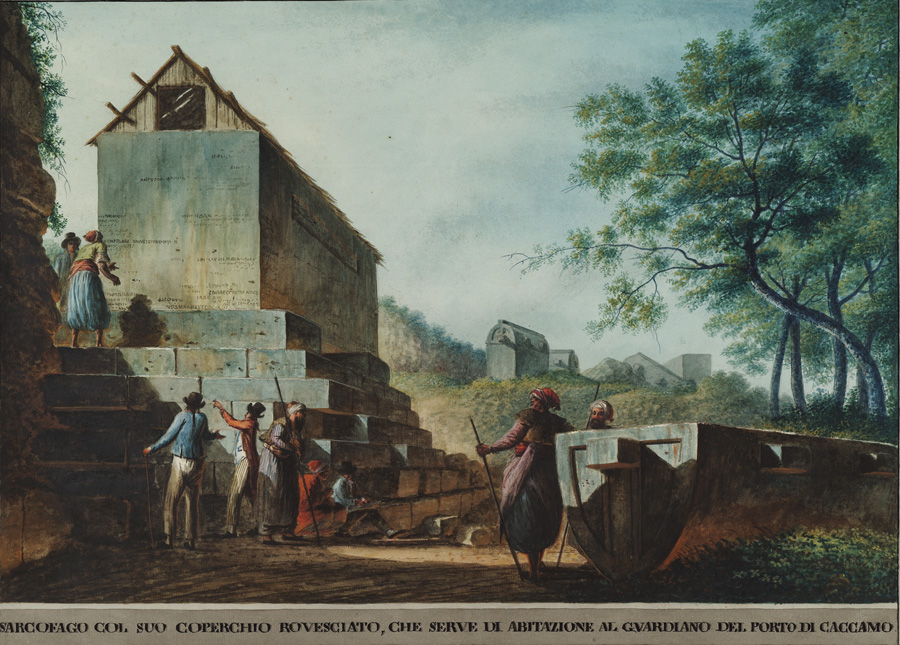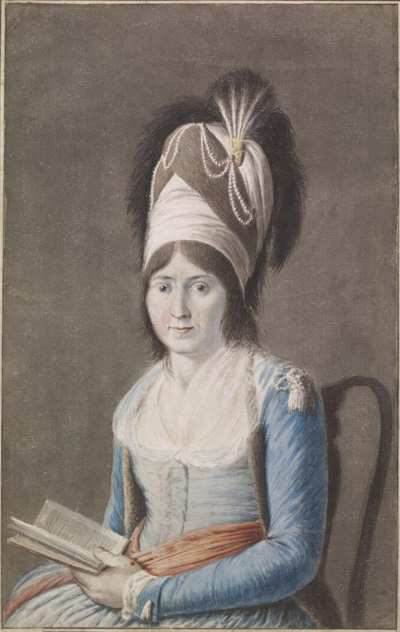
Ephemera
Luigi and Clara Mayer paintings
Request for information - Luigi Mayer and Clara Barthold; Levantine society in Pera, c.1786-94 – Briony Llewellyn
Luigi Mayer (c.1750/55-1803) was an artist from Rome who worked for Sir Robert Ainslie, the British Ambassador in Constantinople, c.1786-94. Mayer made a series of magnificent watercolours of the city and its environs, as well as diplomatic ceremonies, many of which are in the British Museum. In 1792, he accompanied three British travellers, George Graves, Charles Berners and Henry Tilson, on the Ottoman leg of their extended Grand Tour. They visited Egypt, Palestine, Syria and the south-west coast of Turkey, before Mayer returned to Ainslie in Constantinople. In 1794, Mayer accompanied Ainslie on his journey home to England through the Moldo-Wallachian Principalities. Many of his watercolours appeared as aquatints in a series of volumes, published in London, 1801-10.
Although Mayer was working within the parameters of the British Embassy, records on where he lived or his mode of living do not seem to survive. At some point during his stay, he married Clara (or Chiara) Barthold, some of whose family were dragomans. She was said to have been of either Greek or Bulgarian origin, but very little is known of her, how they met or with whom they associated. She too was an artist, possibly taught by Mayer, since her style closely reflects that of her husband.
I have researched Mayer extensively over many years, recently publishing an article on him in Cornucopia (Issue 53, 2015). Philip Mansel and I are currently planning a possible exhibition and accompanying publication. We would like to discover more about the social life of the Levantine community in Pera and Galata, within which Mayer and his wife worked. We also want to learn more about the daily activities within the British embassy under Sir Robert Ainslie. In addition I am looking for original sources where I might find further information about Luigi Mayer or the Barthold family.
Internal view of the Pavilion of the Grand Vizier, where he receives the European Ministers, on the occasion of the Audience of His Excellency Sir Robert Ainslie, His Britannic Majesty’s Ambassador to the Ottoman Porte, on 19 March 1788. Signed Disegnato e dipinto da Luigi Mayer Romano. Watercolour and gouache. Trustees of the British Museum (1947,0319.25).
Encouraged by Britain, the Ottoman Empire declared war on the Hapsburgs and Russia in August 1787. The next spring, Koca Yusuf Pasha, the hawkish Grand Vizier of Sultan Abdülhamid I, established a large encampment at Davutpaşa, ten miles west of Constantinople, before marching towards Austria. Here he gave audiences to several European ministers, including Ainslie and the British delegation. Mayer depicts the elaborate ceremonials for the occasion beneath the Vizier’s distinctive green-roofed tent with curtains of crimson silk. In the centre, the Grand Vizier sits on red cushions, surrounded by his ministers of state, counsellors, an interpreter and army officers, all in red robes. On the right are the executioners with their two-headed battle-axes. Behind the Vizier, as further symbols of his power, is an array of elaborately decorated weaponry. To the left of the Vizier is Sir Robert Ainslie in ceremonial western dress, seated on a low stool, with his own interpreter, his secretary and numerous court attendants. In the left foreground a figure turns towards the viewer, distinguished from his companions by the gold trim on his pocket and hat: this is likely Mayer himself, marking his own role in recording the diplomatic events.
View of the Yalı Köşkü outside the walls of the Seraglio, where the Kaptan Paşa receives the fur cloak from the Grand Signor before his departure for the Black Sea, on 5 April 1788. Signed Disegnato e dipinto da Luigi Mayer Romano. Watercolour and gouache. Trustees of the British Museum (1947,0319.22).
Before departing with his fleet for the campaign against the Russians in the Black Sea, the Turkish Grand Admiral, Cezayirli Hasan Pasha, receives the customary honour of the fur cloak, a symbol that as the Sultan’s proxy he has assumed the imperial mantle for the ensuing conflict. The Kaptan Pasha, a lone figure across the water, bows before entering the kősk to meet the Sultan, who will afterwards pass through the guard of honour to his waiting barge, to the left of the composition. This display of the Sultan’s power and magnificence is witnessed by throngs of Ottoman subjects on both land and water. Numerous smaller vessels from which men and women watch the proceedings crowd the foreground, skilfully arranged by Mayer to draw the viewer’s eye towards the action beyond. On the shore to the right is a large group of veiled Muslim women, interspersed by smaller groups of turbaned men. The 16th-century Yalı Kőşkü, one of several waterfront pavilions at the entrance to the Golden Horn, was built by Selim I for such receptions. Above, on the hillside, the walls of Topkapi Sarayi make an imposing backdrop to the imperial ceremony. Once more Ainslie ensured that his artist recorded with considerable style an event of Ottoman history in which he had played a diplomatic role.
View of the Straits of Constantinople [Bosphorus] towards the Black Sea, seen from Stavros village in Asia, as far as the Giant’s Grave [Yuşa Tepesi]. Signed Disegnato e dipinto da Luigi Mayer Romano. Watercolour and gouache. Trustees of the British Museum (1947,0319.19.)
Mayer’s extensive views of the Bosphorus capture the rural charm and picturesque indented shore-line of the fabled waterway. This one encompasses villages on both sides, extending towards the Black Sea in the distance, with the hill known to Europeans as the Giant’s Grave, and to Turks as Yuşa Tepesi, from a local Muslim saint. In the foreground, on the Asian side, are the tiled roof-tops of large mansions on the hillside at Stavros, the Byzantine name derived from a church with a golden cross for the area known to the Ottomans as Istavros Bahçesi, a popular resort area for the royal family. Later the area became known as Beylerbeyi and in the 19th century a new summer palace was built there. On the European side can be seen the large village of Bebek, and further north the two towers of Rumeli Hisarı, the fortress built by Mehmet the Conqueror to command this narrow part of the straits.
View of the Spring, close by the Village of Belgrade. Signed Mayer pinx. Watercolour. Trustees of the British Museum (1960,0212.13).
The forest of Belgrad outside Constantinople was famed for its abundance of aqueducts and reservoirs (bend in Turkish), built by the Ottoman sultans to supply the city with fresh water. The village after which it is named became a favourite retreat during the hot summer months for wealthier residents of Constantinople, including foreign ministers. The area was much depicted by artists, but Mayer’s views are distinctive for their emphasis on rural life, depicted with characteristic humour. They underlined for Ainslie’s contemporaries and successors the familiarity with Ottoman life for which the ambassador was noted.
Area between the Palace and the Garden of the Gentleman Ambassador of England in Pera, Constantinople. Signed Luigi Mayer dipinse.
Watercolour and gouache. Ömer M. Koç Collection.
In this characteristically quirky composition Mayer presents a behind-the-scenes view of the Ambassador’s domestic life, highlighting the ‘below-stairs’ activities that underlined his official duties. Prominent in the foreground are two servants beating clouds of dust out of a large carpet, while three more members of the household engage in a more leisurely conversation behind.
Sarcophagus with its Overturned Lid, which serves as a Dwelling for the Watchman of the Port of Caccamo. Signed with initials LM.Fe
Watercolour and gouache. Private Collection.
Mayer, in the company of three English travellers, visited these ancient Lycian tombs on the south coast of Turkey, in 1792. The area was then virtually unknown to the West: many of the ruins were accessible only by sea and did not become the subject of archaeological investigations until the mid-19th century. Mayer portrays with humour the mutual curiosity between the western visitors and the local inhabitants. His ‘Caccamo’ probably corresponds to the region of modern Kekova, known for its numerous large free-standing tombs.
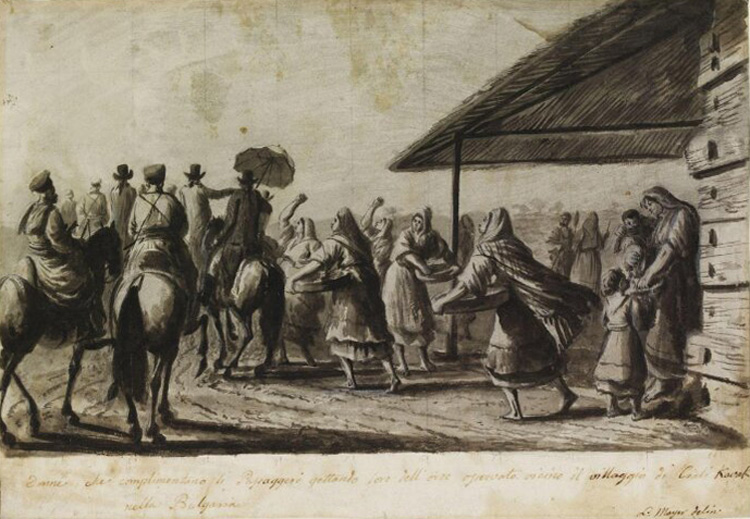
Women greeting travellers by throwing barley to them, observed near the village of Chiali Kavak [Çalı Kavak] in Bulgaria. Signed Mayer pinx. L. Mayer delin.
Ink and wash, squared in pencil. Trustees of the Victoria and Albert Museum (Searight Collection, SD. 650).
As Ainslie and his suite pass through rural Bulgaria, on their route home to England in 1794, local women shower them with barley, like confetti. The village of Çali Kavak is near Shumen (Turkish Şumnu), now in Bulgaria. This unusual sketch shows the liveliness of Mayer’s draughtsmanship, creating a vivid sense of the travellers’ experience as they encounter the customs of the local population.
Portrait of Clara Mayer, 1799.
Watercolour. Trustees of the Victoria and Albert Museum (Searight Collection, SD.661).
Luigi Mayer’s wife, Clara (or Chiara), née Barthold, may have been the sister of a dragoman at the British Embassy. Said to have been of Bulgarian origin, she too was an artist, working in her husband’s style. The couple settled in London after 1795, and after Luigi’s death in 1803 she continued to produce views of Constantinople, most of them versions of her husband’s compositions.
Analysis courtesy of Briony Llewellyn, 2021

